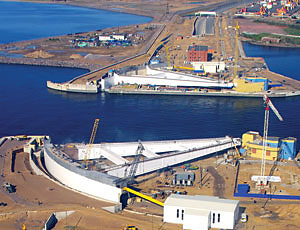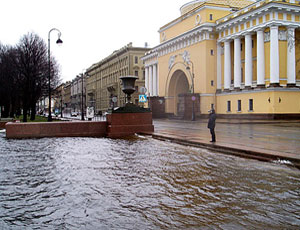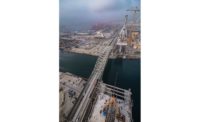Flooding has been a continuing and even predictable problem in Saint Petersburg, ever since Peter the Great founded the city that became the Russian capital in 1703 on low-lying land within the Neva River estuary. Now, after 30 years of planning, construction and delays, a $3-billion barrier fitted with floodgates and carrying one of the city’s major ring roads is nearing completion.
The 25.4-kilometer-long embankment rises 5.5 meters above the normal water level of Neva Bay, protecting it from the Gulf of Finland to the north and east. At the northeast corner, it features a pair of 122-m-long pivoting, pie-slice-shaped gates that can swing shut to prevent rising gulf waters from overflowing the banks of the Neva River, which snakes through the historic city. Beneath the gates, a six-lane highway passes through tunnels that connect the ring road running atop the floodwall.
Although the Neva carries a large volume of water from its nearby source of Lake Lagoda, flooding typically approaches from the west. The city’s location at the eastern end of the Baltic Sea’s Gulf of Finland exacerbates the situation: seasonal low-pressure weather systems and high prevailing winds produce long, low-fequency waves that gain height and volume when they approach the narrow, shallow Neva Bay; more often than not, they top the city’s embankments. A landmark flood in 1955 convinced leaders of the former Soviet Union the city needed flood protection. But it wasn’t until 1978 that a project was approved. Construction began in 1980 on a 14-km-long road, 11 rock-and-earth dams, sluice gates and two navigation passes, but was halted in 1987, when the job was 65% complete. The fall of communism, the dissolution of the Soviet Union, the emergence of Russia as an independent state and lack of money stalled the job for 15 years.
“Environmental groups tried to prove that the water quality would be damaged,” recalls Oleg Iosefovich Panchuk, a deputy general director for Russia’s Ministry of Regional Development. “Dismantling the whole thing was considered.”
Environmental groups worried water behind the barrier would become heavily polluted because the city discharged untreated wastewater directly into the bay. In 2006, city officials opened a wastewater treatment plant that seems to have solved water-quality concerns. “Expert analysis showed that the barrier had no catastrophic consequences to water quality,” says Panchuk.
Because of climate change factors, Russia decided it could potentially be more catastrophic not to finish the floodwall. “The city was founded in 1703, and from the very first day it has been prone to flooding,” says Panchuk. Any rise of 160 centimeters or more in water level constitutes a flood. The worst flood, in 1924, saw a 421-cm rise, he adds.
Halcrow Group, London, led a team including the Dutch firm DHV BV and the Norwegian firm Norplan to begin reviewing the decades-old design when the project restarted in 2003, funded through a $225-million loan from the European Bank for Reconstruction and Development and helped by Russia’s resurgent economy. Supported by local Russian design institutes, the team helped prepare a construction bidding strategy, and drafted technical documents.
“There was a lack of reliable as-built documentation for existing structures. Construction stopped in a partly built state, and the stoppage was not planned,” says David Edwards, Halcrow project director. “We had a lack of personal knowledge of the original design. Due to the length of hiatus, all the original senior designers had...





Post a comment to this article
Report Abusive Comment